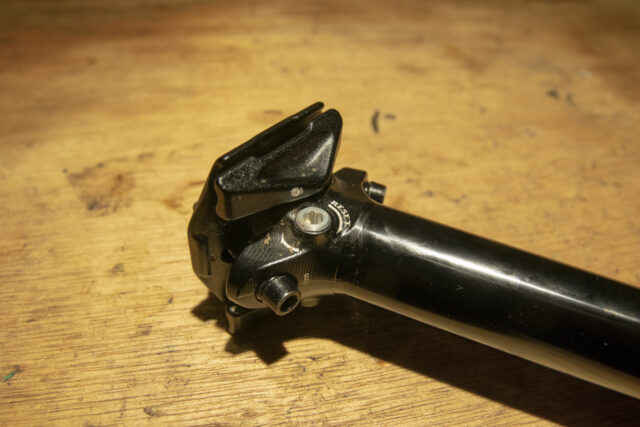Manitou Jack Dropper Post
Available Dropper Lengths: 80, 160, and 185 mm
Available Diameters: 30.9 and 31.6
Configuration Tested: 31.6 mm x 185 mm
Blister’s Measured Weight:
- Seatpost: 578 g
- Remote: 48 g
MSRP (as tested):
Seatpost: $400 with remote
Test Bike: BTR Ranger
Reviewer: 6’, 175 lbs (183 cm, 79.4 kg)
Test Location: Washington
Test Duration: 6 months

Intro
Manitou updated their Jack dropper post earlier this year, and while it’s not the first Manitou dropper to bear that name, the new one is entirely different from the prior generation. And yet it’s a familiar design — because the new Jack is actually a re-branded Bike Yoke Revive. But Manitou has found some details to refine, and while the post itself is functionally the same as the Bike Yoke branded version, Manitou has come up with their own lever, along with some tweaks to the cable routing and clamping setup. So how does that all add up, and what has Manitou changed?

Design and Options
The Jack post is available in 30.9 and 31.6 mm diameters, with 80, 160, or 185 mm of drop, and for bikes with internal dropper post routing only. The 213 mm drop Revive and the 34.9 mm diameter Revive Max aren’t available from Manitou. Like most high-end posts, the Jack uses an air spring to return from the lowered position, and a hydraulic mechanism to lock the post in place at any point in its travel. There’s a conventional two-bolt seat clamp (which uses T25 Torx bolt heads), and the actuator at the bottom of the post can be rotated to whatever angle works best for cable routing and/or clearance. The Jack has a stated rider weight limit of 250 lb.
One of the standout features of the Jack (and the source of the “Revive” name of the original Bike Yoke version) is its self-bleeding design, which allows the rider to purge any air that may have gotten into the hydraulic oil, without needing to perform a full service or even remove the post from the bike. To reset the post, use an Allen wrench to turn the reset valve about a quarter of a rotation with the post extended, then lower the post while holding the valve open; when you let go of the Allen key, the valve will close on its own.


Unlike a lot of dropper posts that use a sealed, replaceable cartridge for the hydraulics, the Jack is fully user-serviceable, and despite the addition of the Revive system, its inner workings are cleverly simple. In short, there are two tubes within the post shaft; the inner one is filled entirely with oil and handles the locking of the post through an internal valve that’s tied to the actuator at the base of the post. The outer tube, which surrounds the inner one, is filled partway with oil, and partially with air. When you push the remote, the valve at the base of the inner tube opens, allowing oil to flow between the inner and outer tubes, freeing the post to move. Putting weight on the seat with the valve open lowers the post, and in doing so displaces oil from the inner tube to the outer one, in turn compressing the air in the upper portion of the outer tube; with the seat unweighted, that air pressure forces oil back into the inner tube from the outer one and raises the seat.
So long as the post is more or less upright, the air will remain at the top of the outer tube with the oil in the lower portion, and air shouldn’t make its way into the inner tube. But nothing seals 100% perfectly, and air definitely can get into the inner tube if you flip the bike upside down or hang it for storage, causing the Jack to become spongy. And that’s where the Revive function comes in. The Revive valve sits at the top of the inner tube, and if the post is lowered by opening that valve (instead of the lower one that’s attached to the remote), oil is displaced up through the Revive valve, pushing out any air that might be in the inner tube above it. Once any air is pushed out, the oil will spill out into the outer tube, where it’ll settle at the bottom (so long as the post is upright), just where it’s supposed to be. And voila — no more air in the inner tube.
That functionality also means that the Jack is more readily user-serviceable than most posts, in part because the hydraulic inner workings don’t need to be bled as part of the service procedure. Manitou doesn’t list their own recommendations, but Bike Yoke actually says that there’s no set interval for servicing the inner hydraulic portion of the post and that it should only be done as needed / if the Revive function stops working. Parts and instructions are nevertheless available. A more basic service of the bushing and guide keys (the brass bits that stop the upper part of the post from rotating) is recommended every 100 hours of ride time and can be done at home without needing to dig into the hydraulic portion of the post.
Of course, that’s all true of both the Jack and the Bike Yoke Revive, because they’re in fact the same post. But Manitou has made their own lever for the Jack, and along with it, some updates to the cable clamping arrangement. The original remote for the Revive was designed to locate the cable end at the lever, so the Revive uses a barrel with a set screw to clamp the cable at the post end. This mostly works fine, but the set screw clamp is prone to damaging cables, causing them to fray and be difficult to reuse, and clamping the cable at the lever end tends to make sizing housing and routing the cable a little easier. (Bike Yoke’s Triggy and Triggy Alpha remotes also feature a clamp at the lever end for maximum flexibility.)
Anyway, Manitou seemed to agree that the cable situation could be improved, and actually got Jagwire to make a custom cable with a barrel designed to replicate the bolt-on Bike Yoke one at the seatpost end for the 160 and 185 mm versions of the Jack; the 80 mm one uses a different actuator and a standard derailleur cable. In many ways, the custom cable is a nicer solution — you don’t have to cut the post end of the cable to an exact length (though both the Revive and the Jack have an etched-on guide to help), there’s one less place for the cable to slip, and there’s no set screw clamp to chew up the cable. The tradeoff, of course, is that the Jack doesn’t directly work with a normal derailleur cable, should you find yourself in need of a replacement, though you can still buy the Bike Yoke cable clamp separately and then use a regular cable. No matter which cable you’re using, the barrel slots into the actuator at the end of the seatpost and can be quickly disconnected without unhooking the cable, should you need to remove the seatpost from the bike for service, cleaning, or whatever else.


On The Trail
The job of a dropper post, first and foremost, is to go up and down when you want it to, and stay put otherwise. And the Jack has done that nicely, but it’s also notable for just how smoothly it raises and lowers. Some dropper posts can feel a bit sticky, and it takes some extra force to get them moving before they break away, or return unevenly with sticky spots in their travel where they slow down appreciably. There’s been none of that with the Jack. It’s also got less side-to-side play than most other posts out there and has otherwise been entirely consistent and reliable in its performance.
The one minor caveat to that is that my bike storage is awfully crowded due to the ever-rotating assortment of review bikes coming through, and I’ve really only got space to hang bikes by their front wheels. That puts the seatpost upside down for storage and means that I need to reset the Jack via the Revive valve each time I take it down off the wall, unlike most other posts. Doing so only takes a moment, especially after adding the Bike Yoke Quick Reset Lever, and has reliably done the job, but it’s still mildly annoying to need to bother. Folks who store their bikes upright won’t have that issue, and the Revive functionality is still very arguably a net positive for staving off the need for a real service for longer than many other posts might require, but it’d be even better to not have to bother at all.

Overall, though, the Jack post is really nice to use. It’s well made, installation was straightforward, it’s impressively smooth and free of side-to-side play, and has generally worked great over most of a season of use.
Unfortunately, the lever gave me more trouble. For one, the paddle sits a little too close to the bar to work nicely with the Hope Tech 4 V4 brakes that I initially tried to set it up with because the clamp bolt on the brake lever interferes with the remote. Hayes Dominion A4 brakes were, unsurprisingly, a better fit, and Shimano XT and SRAM Code levers also work fine, but I still didn’t love the feel and ergonomics of the Manitou remote. The thumb pad on the paddle is on the smaller side and is smooth and a little slippery; there’s also an odd chamfer on the upper side that partially lands under my thumb and feels a little strange. I also tested the Jack post with Wolf Tooth and OneUp dropper levers, both of which worked great and have more agreeable ergonomics for me.

On the plus side, the lever action of the Jack is super light and smooth, and it’s easy to modulate the amount of drop if you’re looking to just inch the post down fractionally to give tired legs a slightly different pedaling position — something I often like to do on longer rides when I’m starting to get gassed. I think the combination of light, smooth lever action, and the especially smooth movement of the post itself really helps here. On stickier-feeling posts, it can be hard to achieve a small drop because it takes some extra force to get the post moving in the first place, which means that you end up blowing through a bunch of drop once it frees up. In most cases, I don’t tend to care too much about just how smooth and light the action of my dropper post is, but that’s one specific instance where the smoothness of the Jack is particularly noticeable and welcome.
Durability
Apart from needing to use the Revive function after hanging the bike for storage, the Jack’s performance has been faultless so far, and given past experiences with the Bike Yoke Revive, I’ve got every expectation that it’ll hold up extremely well. And it’s also nice to know that the Revive is user-serviceable if and when it finally needs it.
Bottom Line
The Manitou Jack is an especially smooth-operating, durable dropper post with top-notch user serviceability and a well-established track record (through the Bike Yoke Revive that it’s based on) of going a very long time between major services. Folks who hang their bikes for storage will need to use the Revive function regularly, which is moderately inconvenient, but the optional Quick Reset Lever makes that easy. Manitou’s own remote is a little clunky and doesn’t work well with every brake out there, but it’ll be fine for some folks, and the Jack works with a lot of other remotes if you’d prefer a different one.

How does it compare to the OneUp post in regards to length and drop and such?
“That puts the seatpost upside down for storage and means that I need to reset the Jack via the Revive valve each time I take it down off the wall, unlike most other posts.”
Yikes!